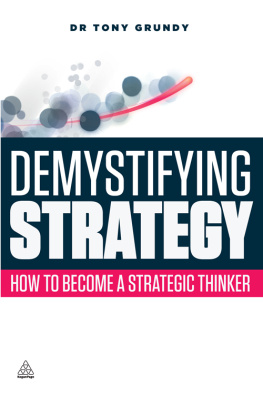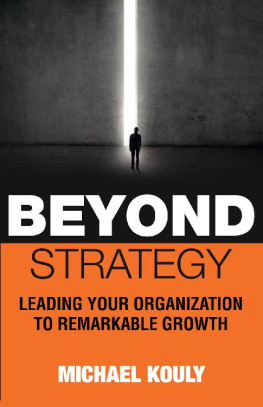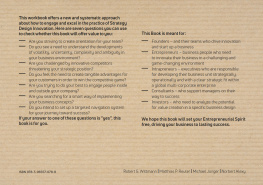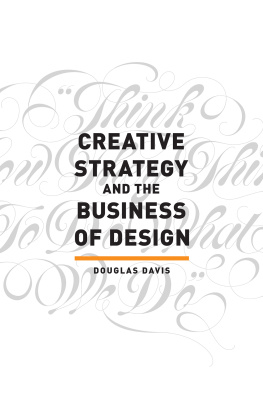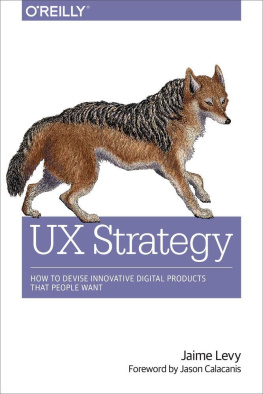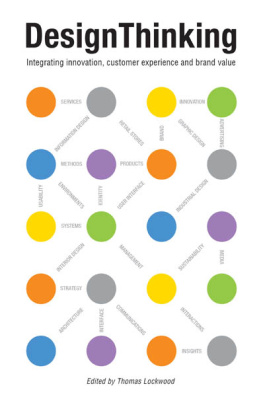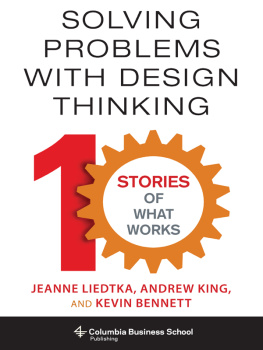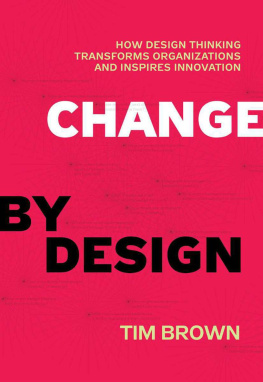James Carlopio - Strategy by Design: A Process of Strategy Innovation
Here you can read online James Carlopio - Strategy by Design: A Process of Strategy Innovation full text of the book (entire story) in english for free. Download pdf and epub, get meaning, cover and reviews about this ebook. year: 2010, publisher: Palgrave Macmillan, genre: Business. Description of the work, (preface) as well as reviews are available. Best literature library LitArk.com created for fans of good reading and offers a wide selection of genres:
Romance novel
Science fiction
Adventure
Detective
Science
History
Home and family
Prose
Art
Politics
Computer
Non-fiction
Religion
Business
Children
Humor
Choose a favorite category and find really read worthwhile books. Enjoy immersion in the world of imagination, feel the emotions of the characters or learn something new for yourself, make an fascinating discovery.

- Book:Strategy by Design: A Process of Strategy Innovation
- Author:
- Publisher:Palgrave Macmillan
- Genre:
- Year:2010
- Rating:5 / 5
- Favourites:Add to favourites
- Your mark:
- 100
- 1
- 2
- 3
- 4
- 5
Strategy by Design: A Process of Strategy Innovation: summary, description and annotation
We offer to read an annotation, description, summary or preface (depends on what the author of the book "Strategy by Design: A Process of Strategy Innovation" wrote himself). If you haven't found the necessary information about the book — write in the comments, we will try to find it.
Strategy by Design: A Process of Strategy Innovation — read online for free the complete book (whole text) full work
Below is the text of the book, divided by pages. System saving the place of the last page read, allows you to conveniently read the book "Strategy by Design: A Process of Strategy Innovation" online for free, without having to search again every time where you left off. Put a bookmark, and you can go to the page where you finished reading at any time.
Font size:
Interval:
Bookmark:
I am indebted to many people who helped me with this book. First and foremost is David Grant, a graphic artist. David arranged for and accompanied me on the initial round of interviews I did in Sydney, Australia, and spent countless hours discussing design with me. He is responsible for a good chunk of my early design-related education.
I am, of course, also indebted to the many designers who so generously gave of their time, experience, and wisdom during the interviews. Thank you Frank Tyneski and colleagues at the Industrial Designers Society of America (IDSA), for all of your help, information, and contacts. Thank you Jeffrey Crass and colleagues at the Design Centre Enmore, Sydney, Australia, for your time and help. Thank you Rolf Pauw for the introduction to the Frankfurt Fair (Messe Frankfurt) and the European designers I was able to interview as a result.
Thank you Troy, for the fantastic cover image and thank you Mustafa, for your help with the model.
Another person responsible for a significant portion of my early design-related education and experience is Deborah Kneeshaw, a graphic designer and an excellent design educator. Deborah and I together ran several executive programs on creative strategic thinking in 1995/1996. During these programs, I learned more about design and its application to strategy development than I can articulate.
I also acknowledge and thank Tim Kiessling, a strategy colleague and friend of mine at Bond University, who was always ready, willing, and able to discuss strategy development and to provide me with ideas and help. I thank Kenichi Omhae, Michael Harvey, Cynthia Fisher, and Ben Shaw for their time, comments, and valuable feedback. Thank you to the staff of the Bond University Library, for your professional service and for finding me the scores of books and articles I continually requested.
I wholeheartedly express my thanks to Karen Lewis, College of Design, University of Kentucky, for providing me with so many excellent examples of design process and output. Thank you Simon Rippingdale and Todd Packer, for your generosity and your willingness to let me use your excellent images.
Finally, thank you my loves Bronte, Cassy, and Morgan. Your love and support are the world to me.
James Carlopio
Bond University
Gold Coast, Australia
jcarlopi@bond.edu.au
An integrated example of the strategy by design process.
| The design process and commentary | Redesigning the JIF Peanut Butter Factory in Lexington, Kentucky By Karen Lewis, College of Design, University of Kentucky |
| The brief, goal, problem | Initially, the idea was to redesign the factory. |
| Questioning the brief Instead of taking that as given and getting on with it, they questioned the brief and took a more holistic approach. | The students looked at the design of the JIF Peanut Butter Factory from two perspectives: the first was the process of making peanut butter and how that impacted the design of the factory; the second was to investigate the impact that the factory and the whole process of making peanut butter had on Lexington, Kentucky. |
| Questioning assumptions | They asked, What was it like for neighbors to live near the factory, drive-by, and interact with it as an economic and industrial institution? Could the peanut butter factory be more than just the worlds largest peanut butter factory, but rather the worlds best factory? |
| An idea worthy of pursuit | In considering these two questions, the studio challenged JIF to become more than just the worlds largest peanut butter factory, but to be an institution that gave back to its community ecologically, economically, and culturally. |
| Research By looking at the wide scope of the peanut butter process, they were able to take a more holistic look at various aspects of the peanut butter making process, the factory, and the surrounding community. | Students started by researching and diagramming the entire peanut butter making process, from the growing and harvesting of peanuts, manufacturing, and finally distribution and marketing in the grocery store. |
| Traditional, background research | They identified that the JIF Peanut Butter Factory in Lexington, Kentucky, is the worlds largest peanut butter factory. Every day, JIF produces approximately two hundred and fifty thousand jars of peanut butter, and processes more than seventy-seven billion peanuts each year. |
| Wide-ranging research of a number of related aspects of the problem with visual output. They look at the resources available and what other companies and institutions were available nearby. | They identified the steps in the peanut butter making process and created a Production Process Diagram (see example 1: The peanut butter production process map). They researched surrounding land uses and values, and produced a land value map (see example 2: Tha land value map) and several visual land value comparisons. They researched site activities and produced an activity map identifying high-use (darker) and low-use (whiter/lighter) areas (see example 3: An activity map). |
| Reformulation of the brief and the problem and creative combination | Students were asked to invent somethingbe it a new product, method, or systemthat would bring two parts of the peanut butter production process together. |
| Concept generation; generate many ideas | One group considered the marketing and distribution aspects of peanut butter, and envisioned new RFID technologies to assemble custom-ordered peanut butter packages. Rather than a single case of crunchy and one of smooth, stores could tailor their orders based on local demographics. Another group suggested harvesting and shelling could be aligned, and proposed a new moisture-wicking peanut harvesting bag that would automatically shell peanuts as they were collected. Still others considered Peanut Butter and Community, Peanut Butter and Real Estate, and Peanut Butter and Social Condenser concepts. |
| Idea-generating exploratory research | The Peanut Paper Project explored how the waste of unused peanut shells could be used by JIF to produce a more sustainable peanut butter product. Currently, raw peanuts are transported to JIF by train several times a week. Peanuts are harvested and shelled on site in Georgia, Alabama, or Texas, where the waste shells are ground up and sold as animal bedding or added to feed. Instead of shelling the peanuts off-site, the Peanut Paper Project looked to see how JIF could use the wasted peanut shells. |
| Further idea-generating exploratory research, creative questioning | In their research, the studio found that peanut shells are 80 percent cellulose. Cellulose, when mixed with water, can be made into paper. Could JIF make its own labels from the peanut shells it ignores? Since 850 peanuts are needed to make one jar of JIF and only 13 peanut shells are needed to produce a standard-sized JIF label, what are there other uses for peanut paper by JIF or Lexington? |
| Further research and concept generation (creative linking of information) | Since the studio also examined the real estate surrounding JIF and considered its potential as a community institution, the Peanut Paper Project recognized JIFs relationship to other surrounding infrastructure. The train spur that brings peanuts to JIF passes by two other Lexington institutions: Lexmark, the international printing company, and the Herald-Leader, the local newspaper, are both located on this same train spur. The Peanut Paper Project suggested the potential to revitalize the underused train infrastructure in Lexington with a productive peanut shell loop. The project suggests that shelled peanuts arrive at JIF, which in turn sends the shells to Lexmark who will make the peanut paper. Lexmark, looking to expand its new paper and printing technologies, then sends the paper to the Herald Leader to print the JIF labels, as well as the newspaper. Using the remaining 837 peanut shells, the Herald Leader could print a 915-page daily paper for their entire circulation. |
Font size:
Interval:
Bookmark:
Similar books «Strategy by Design: A Process of Strategy Innovation»
Look at similar books to Strategy by Design: A Process of Strategy Innovation. We have selected literature similar in name and meaning in the hope of providing readers with more options to find new, interesting, not yet read works.
Discussion, reviews of the book Strategy by Design: A Process of Strategy Innovation and just readers' own opinions. Leave your comments, write what you think about the work, its meaning or the main characters. Specify what exactly you liked and what you didn't like, and why you think so.

